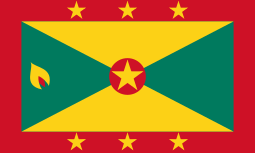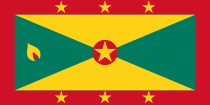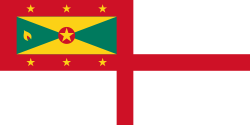Flag of Grenada
The flag of Grenada consists of two yellow triangles at the top and bottom and two green triangles at the hoist and fly. These are surrounded by a red border charged with six five-pointed yellow stars – three at the top centre and three at the bottom centre – along with an additional star on a red disc at the centre and a nutmeg at the hoist triangle. Adopted in 1974 to replace the temporary design used since the islands became an Associated State of the United Kingdom, it has been the flag of Grenada since the country gained independence that year. Designed by a local Grenadian, it utilizes the colours of the Pan-Africanist movement. The representation of a nutmeg is symbolic of the islands' primary export, and was the one feature from the previous flag that was preserved.
 | |
| Use | National flag |
|---|---|
| Proportion | 3:5 |
| Adopted | 7 February 1974 |
| Design | A rectangle divided diagonally into two yellow triangles at the top and bottom and two green triangles at the hoist and fly, surrounded by a red border charged with six five pointed yellow stars, another five-pointed yellow star on a red disc at the centre, and a nutmeg at the hoist. |
| Designed by | Anthony C. George |
 Variant flag of Grenada | |
| Use | Civil ensign |
| Proportion | 1:2 |
History
Sovereignty over Grenada changed hands between the French and the British throughout the 18th century. This continued until 1783, when the Peace of Paris saw France permanently relinquish the island to the United Kingdom.[1][2] It eventually became a crown colony within the latter's colonial empire in 1877.[2] The territory joined the West Indies Federation in 1958 and was a member state of this political union until 1962. On 3 March 1967, five years after the federation was dissolved, Grenada became an Associated State.[1] This gave Grenada full control over domestic matters, while Britain retained responsibility for the territory's foreign affairs and defence. A new flag for the territory was adopted, though this was only intended to be a temporary design. It consisted of a horizontal tricolour of blue, yellow, and green bands, charged with a nutmeg at the centre.[3]
Negotiations on independence commenced after the Grenada United Labour Party won the most seats in the election in August 1967,[1] having campaigned in favour of sovereignty.[2][4] A search for a national flag began soon after.[3] The design by Anthony C. George – a native Grenadian from Soubise in Saint Andrew Parish – was ultimately selected.[5] It eschewed the commonly-used arrangement of a horizontal or vertical tricolour, while maintaining the nutmeg symbol from the previous flag. The new flag was hoisted at midnight on 7 February 1974, the day Grenada became an independent country, and was adopted by the government the same day.[3][5]
Design
Symbolism
The colours and symbols of the flag carry cultural, political, and regional meanings. The green epitomises the islands' vegetation and agriculture,[6][7] while the yellow evokes the sun,[3][7] as well as the warmth and wisdom of Grenadians.[6] The red represents harmony, unity,[3] courage,[7] and vitality.[6] Altogether, these three colours represent the Pan-Africanist movement.[8] The green, yellow and red colour scheme was in turn inspired by the flag of Ethiopia, paying tribute to the oldest independent country in Africa and the only nation other than Liberia to maintain its sovereignty during the Scramble for Africa.[9][10]
The yellow stars on the red border symbolise the country's administrative divisions,[3] while the yellow star on the red disc at the centre signifies the capital, St. George's.[6][7] The symbol of a nutmeg at the hoist alludes to one of the primary agricultural exports of the islands.[7][3] The country is the second-largest producer of nutmeg in the world, trailing only Indonesia.[4] Consequently, Grenada has acquired the nicknames of "Isle of Spice"[11] and "Spice Island".[4][6]
Variants
The civil ensign (for merchant ships) is identical in design to the national flag, but has an aspect ratio of 1:2 (instead of 3:5).[6][5] The naval ensign is based on the British white ensign, a red cross on a white field, with the addition of the national flag in the canton.[12]
| Variant flag | Usage |
|---|---|
 |
Civil ensign |
 |
Naval Ensign |
Protocol
Advice regarding flag etiquette is listed on the official website of the government,[5] as well as on the websites of the country's embassies.[13][14] When displayed together with the flags of other sovereign nations, the foreign flag should not be flown on top of or to the right (i.e. observer’s left) of the Grenadian flag. The only exception to this recommendation is at foreign diplomatic missions on the island, which is also the only place where a foreign flag can be flown without the flag of Grenada accompanying it. When displayed together with domestic flags, the national flag ought to be situated at the centre and be the tallest one of the group. The Grenadian flag should not be smaller in size compared to other flags being flown adjacent to it. When carried in a procession, it should be located on the marching right (in a single file) or at the front of the centre (if there is more than one line).[13][14]
The guidelines also state that the flag is not to touch the ground, nor should it be dipped to an individual or an object. It ought to be displayed either in or near every polling place when Elections in Grenada are held. The national flag should be flown by merchant ships that are registered in the country, but should not be placed on top of motor vehicles (other than by the police force and during state events). It is not to be reproduced for commercial purposes without prior approval from the government. When it becomes damaged and is no longer fit to be publicly displayed, it is permissible to dispose of the national flag via burning.[13][14]
Historical flags
| Historical flag | Duration | Description |
|---|---|---|
.svg.png) |
1875–1903 | A Blue Ensign defaced with the first colonial badge of Grenada. |
.svg.png) |
1903–1967 | A Blue Ensign defaced with the second colonial badge of Grenada. |
.svg.png) |
1967–1974 | A horizontal tricolour of blue, yellow, and green bands, with a nutmeg on a white oval at the centre. |
References
- Britter, Eric V.B. (27 March 2020). "Saint Vincent and the Grenada – History". Encyclopedia Britannica. Encyclopedia Britannica, Inc. Retrieved 9 July 2020.
- "History in Grenada". Lonely Planet. Archived from the original on 9 July 2020. Retrieved 9 July 2020.
- Smith, Whitney (27 July 2011). "Flag of Grenada". Encyclopedia Britannica. Encyclopedia Britannica, Inc. Retrieved 3 July 2020.
- "Grenada country profile". BBC News. BBC. 12 March 2018. Retrieved 9 July 2020.
- "National Symbols of Grenada – National Flag". Government of Grenada. Archived from the original on 24 June 2020. Retrieved 9 July 2020.
- Kindersley Ltd., Dorling (6 January 2009). Complete Flags of the World. Penguin. p. 39.
- "Grenada". The World Factbook. CIA. 8 June 2020. Retrieved 3 July 2020.
- "Flags of Caricom – Grenada". Caribbean Court of Justice. Archived from the original on 9 July 2020. Retrieved 9 July 2020.
- Smith, Whitney (8 October 2013). "Flag of Benin". Encyclopedia Britannica. Encyclopedia Britannica, Inc. Retrieved 9 July 2020.
- Lawal, Shola (13 June 2020). "Red, green and gold: A pan-African history of flags and the remarkable woman who inspired it". Mail & Guardian. Johannesburg. Archived from the original on 2 July 2020. Retrieved 9 July 2020.
- Britter, Eric V.B. (27 March 2020). "Grenada". Encyclopedia Britannica. Encyclopedia Britannica, Inc. Retrieved 3 July 2020.
- "Flag of Grenada – A Brief History" (PDF). Flagmakers. Specialised Canvas Services Ltd. Retrieved 9 July 2020.
- "National Flag of Grenada". Embassy of Grenada in the Russian Federation. Ministry of Foreign Affairs of Grenada. Archived from the original on 9 July 2020. Retrieved 9 July 2020.
- "Significance of the Flag of Grenada" (PDF). Embassy of Grenada in the United States. Ministry of Foreign Affairs of Grenada. July 2010. Archived from the original (PDF) on 9 July 2020. Retrieved 9 July 2020.
